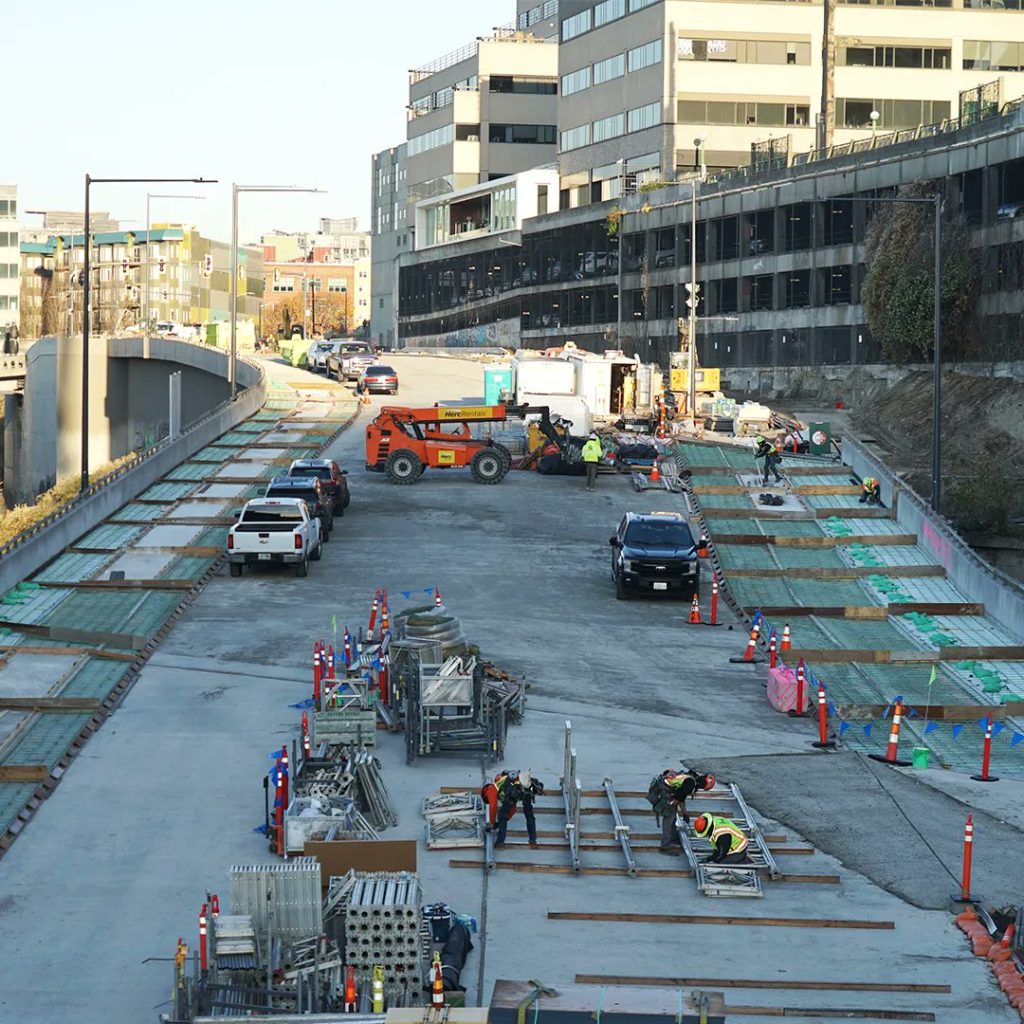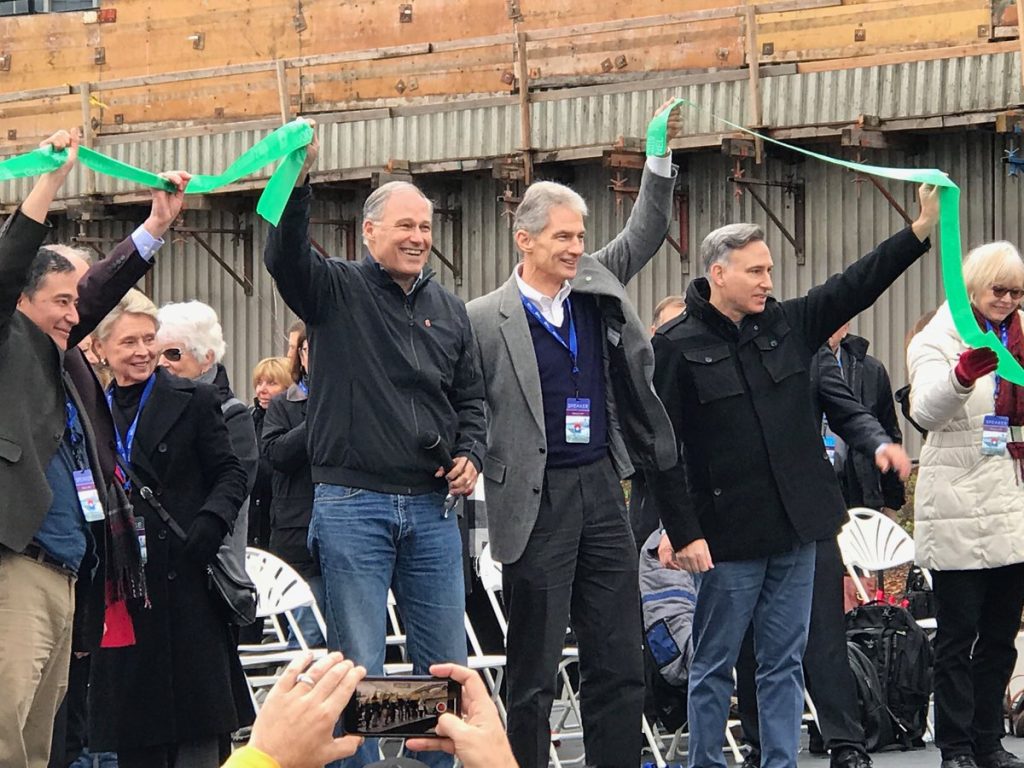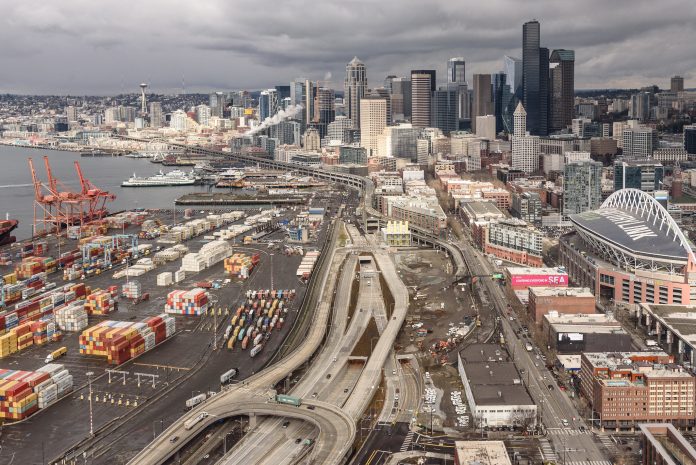To stem a widening revenue gap impacting the SR 99 tunnel tolling program, the Washington Transportation Commission is poised to ask the state legislature for additional funds to make up for toll revenue. Tolls on the deep bore tunnel underneath downtown Seattle were originally set to contribute $200 million toward the cost of the $1.35 billion construction cost plus cover upkeep, but earlier this year the state treasurer’s office came before the commission and warned of a “permanent reduction in revenues” following the onset of the Covid-19 pandemic that likely could not be made up for in toll rate increases, which increase traffic diversion to toll-free surface streets.
The recommendation was included in the commission’s annual recommendations on the state’s overall tolling program and discussed in draft form at last week’s monthly meeting. The request still needs to be approved by the heads of the commission’s tolling subcommittee, but the financials pushing the commission to make that recommendation are stark.
Jason Richter, the state’s Deputy Treasurer for Debt Management, suggested there might be a need for “legislative intervention” when he delivered the dire revenue forecast in July. But just how much intervention depends on traffic volumes inside the tunnel.
This fall, the facility saw some of the highest traffic volumes since the onset of the pandemic, averaging almost 44,000 daily trips in September. But the newly rebuilt waterfront highway is likely going to poach many tunnel trips next year, when a new four-lane overpass near Pike Place Market will provide a direct route between 15th Avenue W and SoDo opens. Even with the autumn surge, toll revenue trajectory is well below the level required to make the tunnel’s financial plan sustainable.

“It is recommended that the Legislature provide non-toll revenues to support closing a SR 99 tunnel funding gap,” the draft language stated. “Traffic and revenue forecasts for the facility project near-term and long-term funding shortfalls based on lower traffic and revenue projections and increased costs compared to initial projections. Support would reduce the size and/or frequency of possible toll rate increases, reducing the financial burden on drivers of the facility compared to relying on toll revenues alone, lessening diversion of traffic to alternative routes.”
Carl See, the commission’s deputy director, told The Urbanist that compared to other toll facilities in the state, like the SR 520 bridge, where toll revenue has been bonded against, the 99 tunnel revenue gap is not as financially urgent to the state.
“When there’s a problem on 520, we’re not meeting financial commitments… that’s a matter of potential default or not being in compliance with a bond covenant. That’s not the case on 99, but we do see it as our responsibility to ensure we’re meeting financial targets, and currently we’re not on target to do that,” he said.
See noted that without the funds toll rates in the tunnel may have to go up as soon as fiscal year 2024, which is set to begin next fall, without an intervention. But toll rates almost certainly couldn’t rise enough to fully cover the gap.
Governor Inslee’s proposed biennial budget includes $16 million to pay back loans on the 99 tolling program, a much higher amount than the $4 million that was assumed when the state treasurer’s office relayed the dire news earlier this year. That amount is coming from a larger $77 million pool of funding secured earlier this year when the Washington State Department of Transportation (WSDOT) prevailed in court against Seattle Tunnel Partners, the corporation formed to build the tunnel that failed to deliver the project on time or on budget. But legislators could have alternative uses for that funding.

While $77 million is a rounding error on most of the state’s highway projects, it is a significant amount when it comes the other programs that WSDOT oversees, many of which are intended to mitigate the impacts of those state highways. It’s $27 million more than the $50 million the legislature set aside earlier this year for the new Reconnecting Communities program, for example, which is intended to repair the damage highway construction has caused in some of the state’s most underserved communities, over the next decade and a half. Funding gaps that pop up on existing highway projects, however, generally take priority over funding those programs.
A 99 tunnel bailout would join other state funds sent to shore up state toll programs, with the legislature earlier this year approving $130 million to lower tolls on the Tacoma Narrows bridge. In addition, the 16 year Move Ahead Washington transportation package allocates $380 million toward highway projects along the I-405 and SR 167 corridor, many of which had been depending on revenue from tolls along I-405 that fell short during the pandemic.
Another fight in the legislature over allocating funds to the SR 99 tunnel could be déjà vu for many state lawmakers after a decade-long fight to determine how to proceed with replacing the Alaskan Way Viaduct along Seattle’s waterfront. In 2010, an amendment to the bill authorizing the tunnel that could have put Seattle itself on the hook for any cost overruns in the project galvanized opposition to the tunnel, with Mayor Mike McGinn ultimately losing his battle for a surface-level alternative with a strong transit component thanks to a lack of support from the Seattle City Council at the time. A similar bill forcing Seattle to pay for cost overruns reemerged in 2017 — following a three-year delay to the project caused by the tunnel-boring machine breaking down.
During the Transportation Commission’s meeting last week, commissioner Jerry Litt, who represents Grant County, joked that the commission might prefer to wrap a bow on the 99 tunnel and gift it to King County or the City of Seattle instead of having to ask the legislature for additional funds. That’s one gift that those local governments would be sure to send right back. Just a few years after the tunnel’s grand opening, it looks like it has become a White Elephant that no one wants to keep in their stocking.
Ryan Packer has been writing for The Urbanist since 2015, and currently reports full-time as Contributing Editor. Their beats are transportation, land use, public space, traffic safety, and obscure community meetings. Packer has also reported for other regional outlets including Capitol Hill Seattle, BikePortland, Seattle Met, and PubliCola. They live in the Capitol Hill neighborhood of Seattle.



